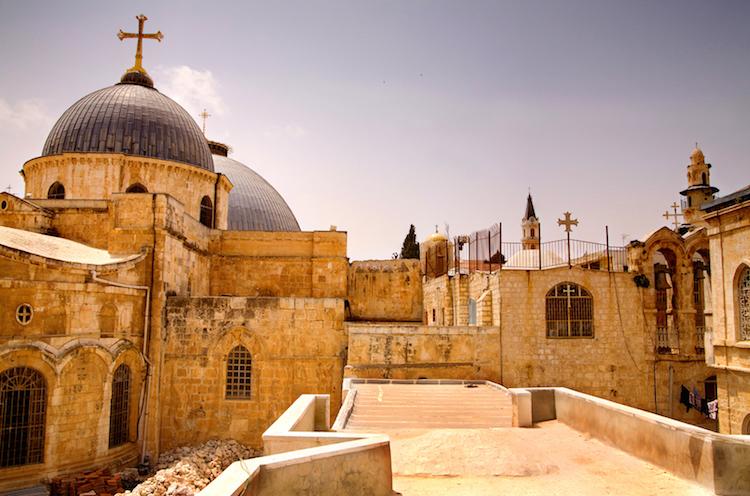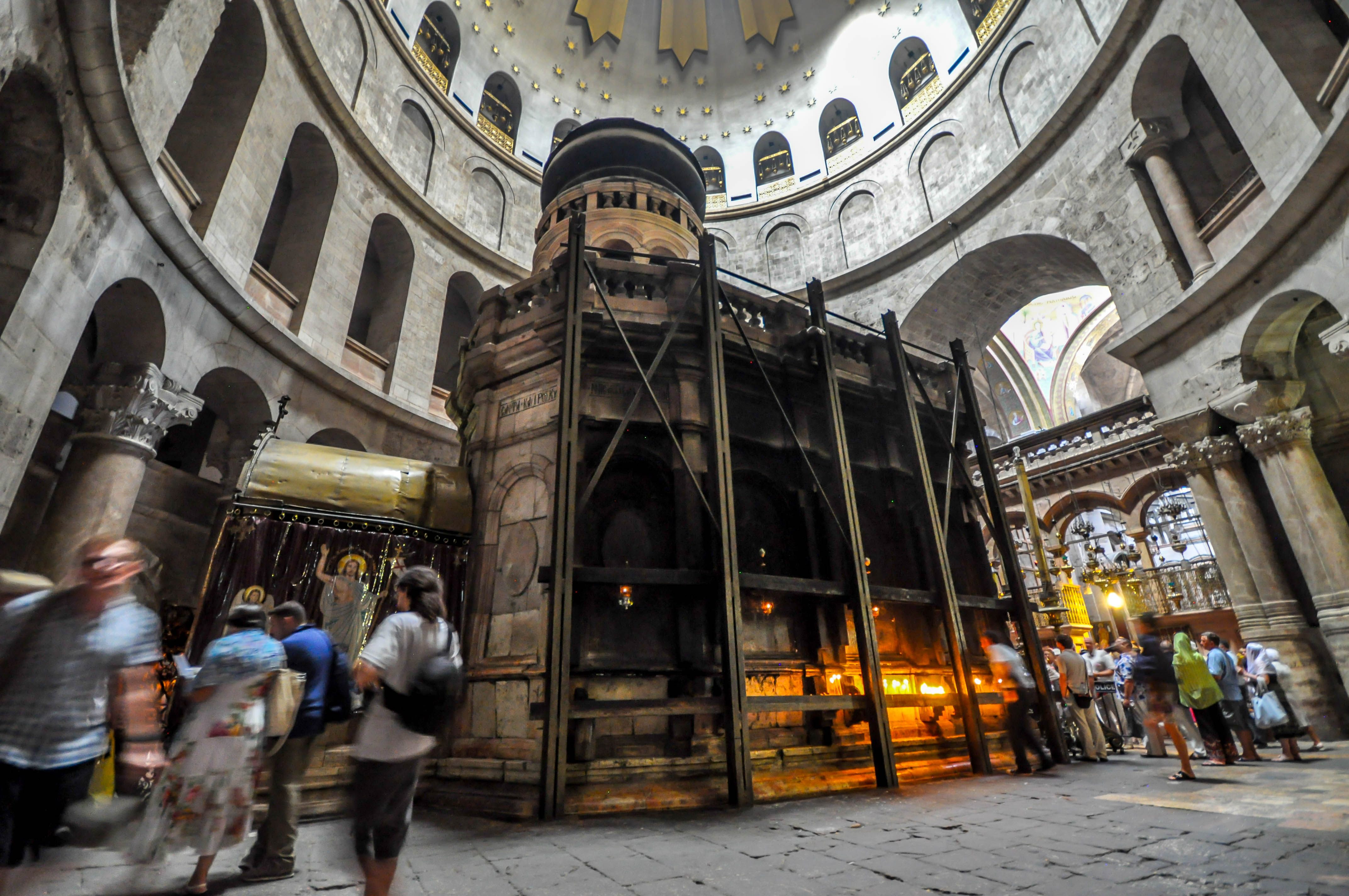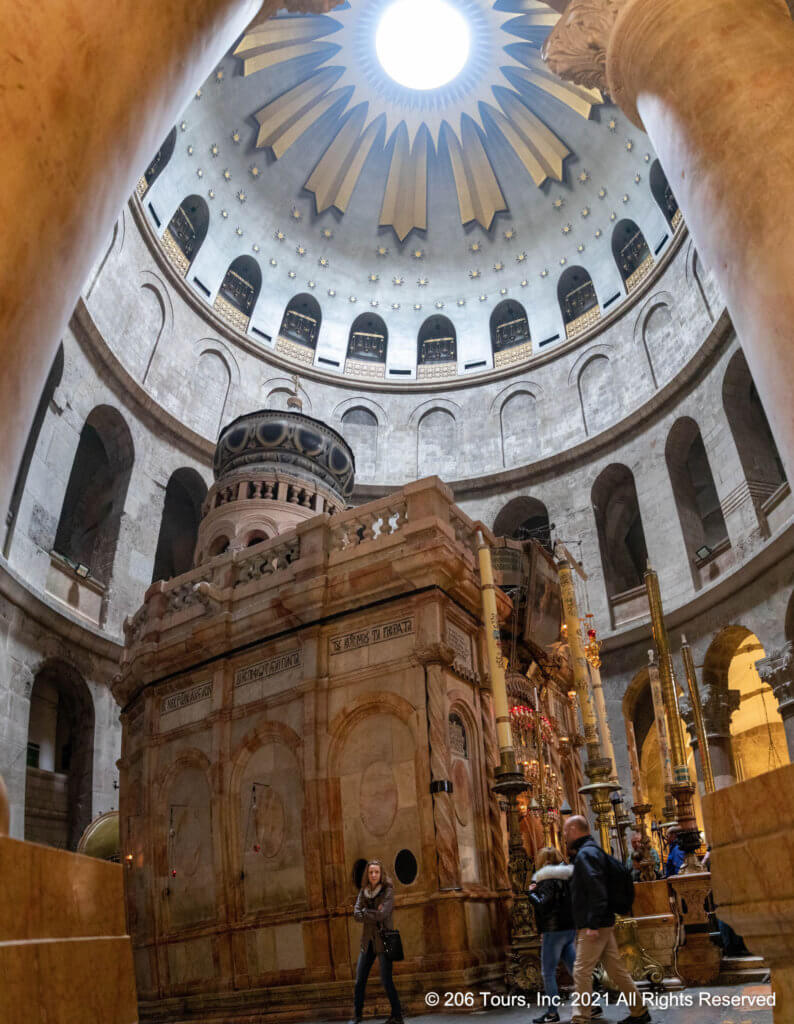Holy Sepulchre: Walk Where Jesus Walked in Jerusalem

History and significance of Holy Sepulchre
The Holy Sepulchre's history dates back to the 4th century when Constantine the Great ordered the construction of a church over the site of Jesus' tomb. Over the centuries, the church has undergone numerous renovations and additions, with various rulers and religious groups contributing to its architectural and artistic legacy.
For Christians, the Holy Sepulchre is the most sacred site in the world. It is believed to encompass both the Calvary, where Jesus was crucified and the empty tomb, where he was resurrected. In addition, the church holds great spiritual significance as the site of several key events from Christ's life, including his burial, resurrection, and ascension into heaven. Thousands of pilgrims flock to the Holy Sepulchre every year to pay their respects and deepen their faith.
Furthermore, the Holy Sepulchre holds cultural significance as well. Its unique blend of architectural styles, from Romanesque to Gothic to Renaissance, reflects the diversity of religious and cultural influences in the region. The church's elaborate mosaics, frescoes, and sculptures, many of which date back centuries, offer a glimpse into past generations' artistic and spiritual legacies.
The Holy Sepulchre is a deeply meaningful and awe-inspiring site representing the intersection of history, religion, and culture. Whether you are a believer or not, visiting this sacred place is a once-in-a-lifetime experience that will enrich your understanding of the world's diverse spiritual traditions.

Location and Hours of Holy Sepulchre
Location of Holy Sepulchre in Jerusalem
When you visit Jerusalem, make sure the Holy Sepulchre is on your list of must-see sites. The church is located within the Old City walls, in the Christian Quarter. You can easily find it by following the signs or hiring a local guide. As you approach the church, you will see the distinctive dome and bell tower visible from afar.
Hours of operation for visitors
The Holy Sepulchre is open daily, with varying hours depending on the season. If you plan to visit, it is best to check the official website or contact the church directly to confirm the hours of operation. Typically, the church opens early in the morning and closes in the evening, with a break for services in the middle of the day.
Visiting the Holy Sepulchre may require patience as it is a popular destination for tourists and pilgrims. However, the wait is well worth it, as the experience is both humbling and awe-inspiring. As you enter the church, you will feel a sense of peace and reverence that is hard to describe. The architecture and artistic elements are truly unique and reflect the region's deep spiritual and cultural legacy.
It is important to note that the Holy Sepulchre has a dress code. Visitors must dress modestly and respectfully, with covered shoulders and knees. Photography is allowed in some areas but not all, so check the signage.
Visiting the Holy Sepulchre is an experience like no other. It offers a glimpse into the region's rich history, culture, and spirituality. By following the location and hours of operation, you can plan your visit and make the most out of this unique opportunity.

Calvary, the Chapel of Adam, and Limestone Tombs
When you visit the Holy Sepulchre in Jerusalem, explore the various chapels and tombs within the church. Each one holds significant spiritual and historical importance and is a testament to the deep cultural legacy of the region.
Chapel of Calvary and its significance
The Chapel of Calvary is located at the front of the church and marks the spot where Jesus was crucified. This sacred site is considered one of the most important in Christianity, as it symbolizes the ultimate sacrifice made by Jesus for the salvation of humanity. Standing in this chapel, you can feel the weight of history and the depth of faith sustained for centuries.
Chapel of Adam and its history
According to the Bible, the Chapel of Adam is located beneath the Chapel of Calvary and is believed to be the burial place of Adam, the first man. This chapel was discovered during excavations in the 12th century and has been preserved as a testament to the origins of humanity and the importance of spiritual redemption.
Limestone Tombs and its religious importance
The Limestone Tombs are located in the basement of the Holy Sepulchre and are believed to be the final resting place of early Christians and members of the royal family of Jerusalem. These tombs hold special religious significance, reminding them of the eternal nature of life and death and the ultimate promise of resurrection.
A visit to the Holy Sepulchre is an experience like no other. By exploring the various chapels and tombs, you can gain a deeper understanding of the region's rich spiritual and historical significance. With its stunning architecture, unique artistic elements, and profound spiritual resonance, the Holy Sepulchre is a must-see destination for any traveller. So, make sure to add it to your list and discover the wonder and beauty of this historic landmark.

Stone of Anointing and the Rotunda
As you explore the Holy Sepulchre in Jerusalem, you will encounter many incredible chapels and tombs with significant spiritual and historical importance. The Chapel of Calvary, the Chapel of Adam, and the Limestone Tombs each offer a unique glimpse into the deep cultural legacy of the region. But there are two other notable sites within the church that you must not miss: the Stone of Anointing and the Rotunda.
Significance of Stone of Anointing
The Stone of Anointing is located at the entrance of the church and marks the spot where Jesus' body was prepared for burial after his crucifixion. It is believed that Joseph of Arimathea anointed Jesus' body with spices and oils on this stone before he was laid in his tomb. This sacred site is considered one of the most revered in Christianity and serves as a reminder of the ultimate sacrifice made by Jesus for the redemption of humanity.
Details on the Rotunda and its design
The Rotunda is located at the centre of the Holy Sepulchre and is one of the most striking architectural features of the church. This circular chamber was built in the early 4th century and housed the Edicule, a small structure enclosing Jesus's tomb. The Rotunda itself is adorned with stunning mosaics and frescoes depicting scenes from the Old and New Testaments. The design of the Rotunda is considered a masterpiece of Byzantine architecture, and its intricate details are sure to leave you in awe.
As you stand before the Stone of Anointing and explore the breathtaking Rotunda, you will be immersed in the Holy Sepulchre's rich spiritual and historical significance. The landmarks within the church are a powerful testament to the enduring faith of millions of people throughout the ages. So, make sure to add these sites to your itinerary when you visit the Holy Sepulchre and discover the wonder and beauty of this historic landmark.

Explore the Edicule (Tomb of Christ)
If you plan to visit the Holy Sepulchre in Jerusalem, make time for one of the most revered sites within the church - the Edicule, also known as the Tomb of Christ. This small structure encloses the tomb where Jesus' body was laid to rest after his crucifixion, and it holds deep spiritual significance for millions of Christians around the world.
History and architecture of the Edicule
The Edicule was built in the early 19th century, but it was constructed over an earlier structure erected in the 4th century. The current design is a beautiful blend of Baroque and Ottoman architecture, and the ornate details will leave you in awe. The structure was built to protect the tomb from damage and to allow access for pilgrims who wished to pay their respects at this sacred site.
Restoration efforts to preserve the Edicule
Over the years, the Edicule has suffered significant damage due to centuries of use and exposure to the elements. Recently, a major restoration effort was launched to preserve this important landmark. The restoration project included cleaning and repairing the structure, reinforcing the foundation and improving the site's accessibility for visitors.
If you're lucky enough to visit the Holy Sepulchre and explore the Edicule, you'll be standing at the heart of one of the most significant sites in Christianity. This landmark's spiritual energy and historic beauty are sure to leave you with a deep reverence and awe. So, don't miss out on this incredible opportunity to connect with history and faith - plan your visit to the Holy Sepulchre today.

Greek Orthodox, Roman Catholic, and Armenian Church Chapels
You are in for a treat on your visit to the Holy Sepulchre! Don't miss out on exploring the three chapels within the church that are run by different denominations of Christianity - the Greek Orthodox Chapel, the Roman Catholic Chapel, and the Armenian Church Chapel.
Details on individual chapels and their historical significance
The Greek Orthodox Chapel is the largest of the three and is located to the right of the entrance. This chapel is home to numerous beautiful icons and frescoes, and it holds special significance for the Greek Orthodox community as they have been entrusted with the care of the Holy Sepulchre for centuries.
The Roman Catholic Chapel, the Chapel of the Franciscans, is directly across from the entrance. This chapel was built in the 1920s and features a stunning mosaic depicting the resurrection of Christ.
The Armenian Church Chapel is located on the left side of the church and is perhaps the most visually striking of the three. It features beautiful stone carvings and intricate metalwork, including an ornate altar that will leave you in awe.
Each of these chapels offers visitors a unique perspective on the holy site, and exploring all three is a must-do on your visit. With each chapel representing a different denomination of Christianity, you'll get a sense of the diversity and unity of faith at the Holy Sepulchre.
The Holy Sepulchre offers visitors a once-in-a-lifetime opportunity to connect with history and faith. From exploring the Edicule to marvelling at the individual chapels' beauty, your visit will leave you with a deep reverence and awe. So, what are you waiting for? Plan your trip today and experience the wonder of the Holy Sepulchre for yourself!

Sights and Sounds of Holy Sepulchre
You are in for a real treat when you visit the Holy Sepulchre. Make sure to explore the three chapels within the church, each run by different denominations of Christianity: the Greek Orthodox Chapel, the Roman Catholic Chapel, and the Armenian Church Chapel. The experience of each of these chapels is unique and will leave you with a sense of reverence and awe.
Religious ceremonies and rituals held at Holy Sepulchre
The Holy Sepulchre is home to several religious ceremonies and rituals held throughout the year. The Mass is celebrated here most days of the week, and the Franciscans lead a daily procession. These events are open to the public, and you can witness the unique customs of the respective religious denominations.
Visiting tips to get the most authentic experience
When visiting the Holy Sepulchre, it is essential to dress modestly and appropriately, covering your shoulders and knees. Be respectful when visiting the chapels, and avoid taking photographs or using your phone while inside. It’s also a good idea to visit during quieter hours to fully absorb the serenity and peace of the site.
The Holy Sepulchre is a unique and unforgettable destination for those looking to connect with their faith and connect with history. Don't miss out on experiencing the different chapels and religious ceremonies held within the church. By following these tips, you can ensure you get the most authentic and respectful experience possible. So pack your bags and plan your visit to the Holy Sepulchre today!

Holy Sepulchre Museum
When you visit the Holy Sepulchre, you don't just experience the sights and sounds of the holy site; you can also explore the museum within the church. The Holy Sepulchre Museum has a vast collection of artefacts, ranging from centuries-old mosaics to ancient manuscripts.
Details on Holy Sepulchre Museum and its exhibits
The museum is divided into six sections, each showcasing different artefacts and exhibits that tell the story of the church's history and significance. These include:
- The Classical Period - featuring artefacts from the Roman and Byzantine empires
- The Crusader Period - showcasing items from the time of the Crusaders, including armour and weapons
- The Ottoman Period - displaying objects from the Ottoman Empire's reign over the Holy Land, such as pottery and tiles
- The Franciscan Period - highlighting the role of the Franciscan order in the conservation and upkeep of the church
- The Armenian Period - featuring items and objects from the Armenian Church's history and tradition
- The Greek Orthodox Period - showcasing the unique stories and artefacts from the Greek Orthodox Church's perspective
Visitors to the museum can marvel at the intricate details of the exhibits, including mosaics and frescoes that date back to the 12th century or gaze upon the holy relics displayed in glass cases. The Holy Sepulchre Museum gives visitors a chance to delve deeper into the history and significance of the church and understand the unique perspectives of different denominations.
Make sure to allocate enough time to visit the Holy Sepulchre Museum, as there is so much to see and explore. With the knowledge and appreciation gained from your visit, you will leave with a deeper understanding of the holy site's significance and a newfound respect for the people who have cherished and preserved it over the centuries.
